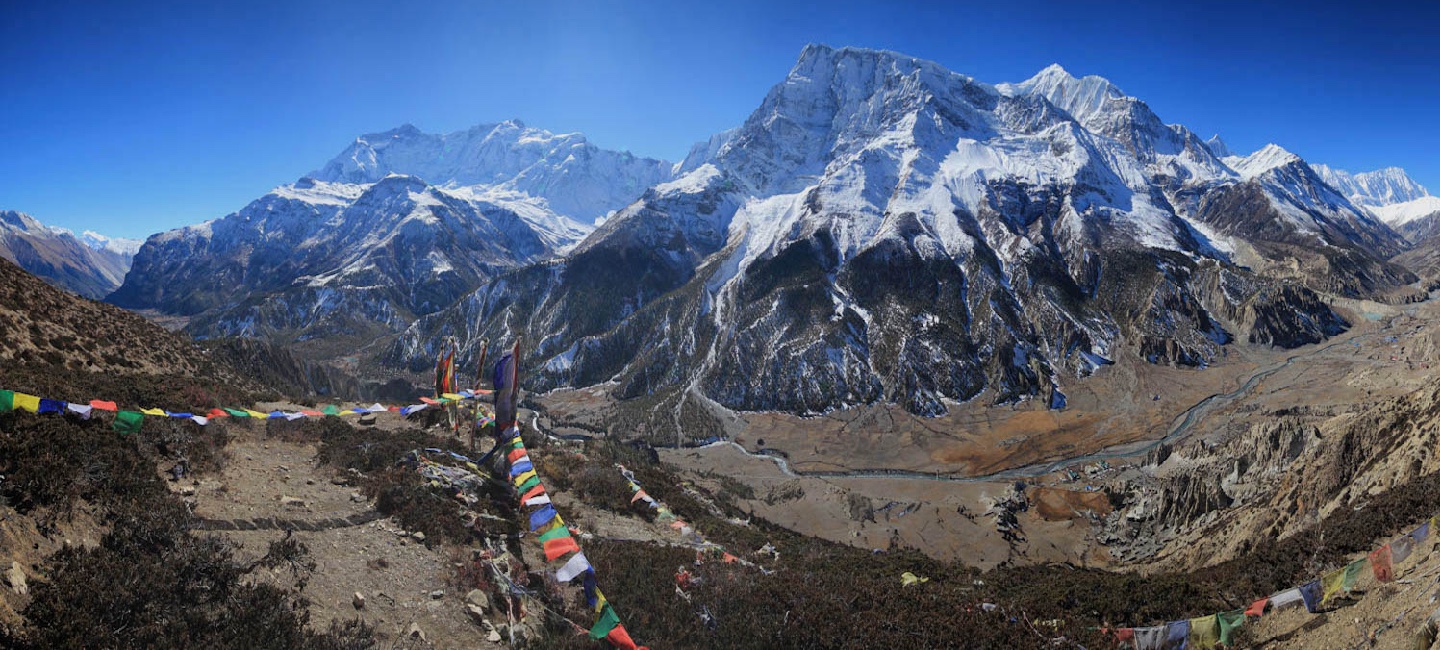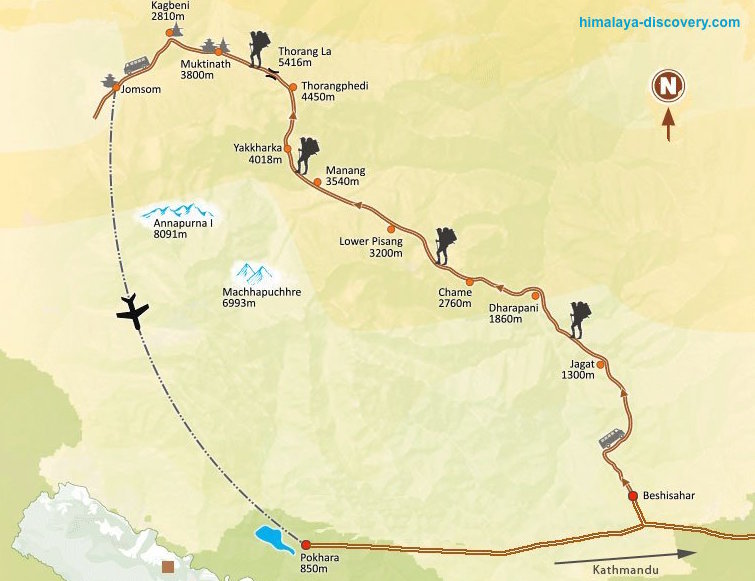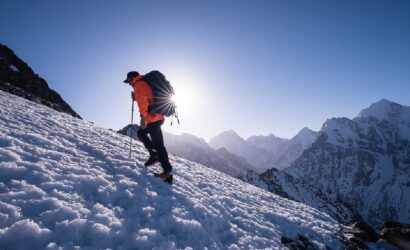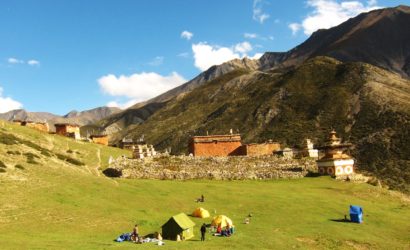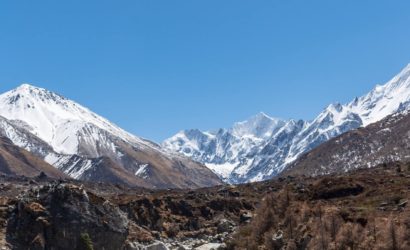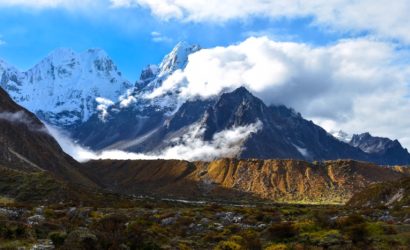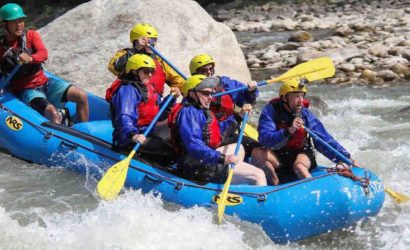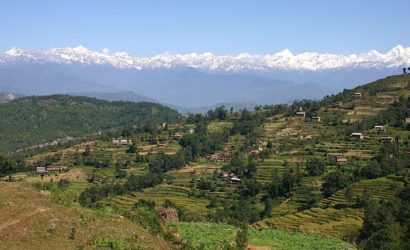What is the first image that comes to mind when you imagine Nepal?
The most common answers we receive are “mountains,” “cliff faces,” and “Sherpas.” But what if we tell you that the Annapurna Circuit takes you through dense jungle and sprawling rice fields in the clouds? Or that one second you’re forging a path through undergrowth, the next you’re walking on snow-capped mountains?
Passing through several distinct landscapes, this legendary trek around the Annapurna Mountain range—named after the Hindu goddess of food and nourishment—feeds the soul and heals the mind. You loop from the cobwebs of everyday life as you loop from one village to the next, and after going through the highest point at Thorong La Pass (5,416m), you walk down the mountain feeling cleansed.
Highlights of Annapurna Circuit 14 Days
- Explore the majestic Himalayas in the north, featuring iconic peaks such as Annapurna, Dhaulagiri, Machhapuchhre, Himchuli, and more.
- Embark on a challenging hike to the Thorong La Pass, reaching an elevation of 5,416 meters above sea level.
- Discover the cultural richness of Jomsom and Muktinath, immersing yourself in the diverse traditions of these places.
- Engage in religious rituals at Muktinath and explore the significance of the 108 Sprouts and the Eternal Flame.
- Visit Tibetan Monasteries in Manang and the charming Braga Village, gaining insights into the local religious and cultural practices.
- Experience cross-cultural activities along the Annapurna Circuit Trail, fostering a deeper understanding of the region’s diversity.
Is 14 Days Annapurna Circuit Trek For You?
Of course, the 14-day Annapurna Circuit Trek is certainly for you. If you are craving for the natural wonders and the landscapes along with the scenery of the Himalayas, we highly recommend this trek for you.
The 14-day Annapurna Circuit Trek is moderately-difficult, so trekkers should expect physical challenges as well as difficulties with the remote terrain. This is a suitable route if you have experience trekking.
Trekkers need to be physically fit for this trek because it has remote and rocky areas with tough trails. Walking through these places can be hard, and altitude is high. So, if you’re not used to high altitudes, train beforehand. Having a guide during the Annapurna Circuit Trek is highly recommended.
How Difficult is This Trek?
As mentioned above, the Annapurna Circuit Trek is moderately difficult. It means that beginner as well as intermediate and highly experienced trekkers can embark on this trek.
One of the most important things that trekkers must know is they need to walk for around 6 to 8 hours daily. And this might be physically draining for some trekkers. But keeping these things in mind beforehand and preparing oneself with high endurance and stamina will give you the right result.
Embarking on this adventure unfolds a wide range of experiences. Trekkers will embark on a multi-day journey navigating through the unbeaten trails of rocky and slippery landscapes, immersing oneself in the challenge and thrill.
This trek finally leads you to Thorong La Pass, at a towering altitude of 5416 meters, where the air is thin, and altitude sickness can be a really big issue.
When is the Perfect Time To Do This Trek?
Taking the 14-day Annapurna Circuit Trek is a wonderful adventure, especially in the Autumn (September-November) and Spring (March-May). During these times, the weather is nice, and the sky is clear, giving you a beautiful view of the Himalayas in the north. You can have amazing views of not only the Himalayas but also charming villages and lush green forests of the Annapurna region.
Especially during the Spring and Autumn seasons, the weather is very stable, calm and friendly. The probability of the rainfall and snowfall during these times are very low around the Annapurna region.
With the clear views of the surroundings, trekkers can delve themselves into one of the most attractive landscapes in the world. Besides, you can look deeper into the Nepalese culture and tradition as major festivals like Dashain, Tihar, Nepali New Year, and others fall in the Autumn and Spring seasons.
What Are Permits Needed For Annapurna Circuit Trek?
The Annapurna Circuit lies within the restricted zone of the Annapurna Conservation Area and trekkers require permissions to enter its premises. The Conservation Area is home to various endangered species, including the Snow Leopard, Blue Sheep, Himalayan Tahr, and numerous others.
It’s essential to adhere to these regulations to ensure the protection of the unique and diverse ecosystem in this region. Your cooperation in obtaining the necessary permits plays a crucial role in supporting conservation efforts and maintaining the delicate balance of this natural habitat.
When undertaking our 14-day Annapurna Circuit Trek, it’s essential to secure the required permits. These include the Annapurna Conservation Area Permit (ACAP) and the TIMS Card, necessary for entry into the region. To obtain these permits, visit the Tourism Board in Kathmandu, where you’ll need to submit documents such as photographs, visa copies, and relevant travel documents.
To access the Annapurna Conservation Area, foreign trekkers are required to obtain a permit, priced at approximately NPR. 3,000 per person per entry. However, trekkers from SAARC countries such as India, Sri Lanka, Bangladesh, and Afghanistan enjoy a reduced fee of NPR. 1,000 per person per entry.
Moreover, there are no fees or permits required for trekking in the Annapurna Circuit if you are under the age of 10. Additionally, the fee for the TIMS Card (Trekkers Information Management System) is NPR 2,000 for foreign trekkers and NPR 1,000 for citizens of South Asian countries (SAARC).
This is the first day of your trekking package in Nepal. You will arrive at Tribhuvan International Airport from your home country. Our officials will be waiting for you in the Airport and later, they will escort you to your respective hotels.
We wake up early, our driving journey starts in the morning from Kathmandu to Chame via Besisahar by Toyota Hiace minibus then by jeep to Chame. You will drive through scenic foothills and ridge line vistas along the Trishuli River.
From Munglin, you follow the Pokhara highway till Durme then turned towards the north to Besisahar along the Marshyangdi River enjoying Mountain views, terraces field and green hills. Overnight at guesthouse.
On the third day, your Annapurna Circuit Trek takes you to picturesque Pisang village, amidst towering mountains. You’ll walk slowly after a leisurely breakfast through a fragrant pine forest, its scent mingled with that of the Rhododendrons.
The goal is to reach Pisang. This begins the journey slowly toward Bhartang. The terrain today is mainly flat, with some rocky patches. Along the way, see breathtaking glimpses of snow-capped mountains and rivers. Travelers drink in the splendor of Nepal’s mountain region.
Past Bhartang, the trail leads to Dhukur Pokhari through several suspension bridges. On the way is SwargaDwari, a sacred site on a distant hill. It will take about 5-6 hours to make the journey to Lower Pisang (3,200m).
But the trek is not over yet. You’ll be climbing up to Upper Pisang (3,300 m). Tonight you’ll take your ease here amidst the beauty of Himalayan civilization. Relish the sweeping vistas of Chulu peaks, Tilichi, Annapurna massifs and Nawal peaks from this elevated spot.
The journey to Manang begins, following a big breakfast in Pisang. The Himalayan trekking routes pass by Manang, an advanced civilization which attracts many trekkers who take an extra day to visit its historical sites and acclimate to the high altitude.
Today’s journey, which takes around 6-7 hours, follows the flat path to Manang Valley to an altitude of 6,540 meters. On the route, you’ll pass through Braga, a Tibetan village with distinctive architecture; Gompa, museum; and Himalayan-style lodges.
Along the way there are Tibetan-style painted Mandalas, dragon mouths and yak grazing fields. You can feast your eyes on the mighty Annapurna II, III, Gangapurna and Chulu Peak from Manang. As you prepare for a restful night, accommodations and meals are provided at the best available lodge.
Trekking above 3000 meters means you have to acclimate, so today is a rest day. Finally, this well-deserved break lets trekkers drink in the high mountain scenery. They can start their day late and enjoy a richly satisfying breakfast with coffee. Most will trek on to Gangapurna Lake, which is just 15 minutes from the resting point.
You can opt to hike to the hillside monastery, offering a stunning view of the Himalayas, and visit Tibetan-inspired gompas and monasteries. Following exploration, return to the lodge for a delicious meal and a restful night’s sleep before resuming the Annapurna circuit the next day.
The hike through Manang is the most demanding of trekkers. After a rich breakfast you climb from the Marsyangdi Valley to Upper-Manang village, Tanki Manag, and on into Gunsang in the Himalayas. The trail next brings the hiker to the Yak Kharka grassland.
The journey to Yak Kharka is hard, but the terrain then becomes easier. If you trek for about 4 or 5 hours, you’ll arrive at Yak Kharka in time to rest and eat some delicious food amidst the magnificent Annapurna massifs, Pisang, Gnagapurna and other Himalayan gems.
On the seventh day of your hike, there is a short trek to assist acclimatization. The 3-4 hour journey involves crossing a suspension bridge then making for the junction of Jarsang Khola (4,610 m) and Phedi (4,420 m). Having crossed the grassy fields and a rocky track you will come to Thorong Phedi.
With traditional villages and settlements, this high-mountain area has fabulous views of snow-capped mountains such as the Annapurna massifs, Gangapurna or other Himalayan ranges. One may also catch a glimpse of wildlife like snow leopards, which surface on the icy-rock slopes.
Today, we will embark on a truly memorable experience. The journey commences from Thorong Phedi, leading you to the majestic Thorong La Pass and the sacred destination of Muktinath in the northern region of Nepal. Traverse the less-traveled paths while reveling in the breathtaking vistas of Annapurna, Dhaulagiri, Gangapurna, Himchuli, and more.
Thorong La Pass, standing at an impressive 5416 meters, marks the pinnacle of this trek. The descent from this lofty point to Muktinath unfolds through a steep path, requiring approximately 3-4 hours. Muktinath holds immense cultural and religious significance for both Hindus and Buddhists, offering the chance to engage in holy rituals within the temple premises. The temple boasts 108 sprouts, where, according to Hindu belief, cleansing sins is possible through ritualistic bathing. Additionally, the perpetual flame, burning for centuries, adds to the allure of the region. Following temple exploration, retreat to a nearby tea house for a restful overnight stay.
From Muktinath, we will reach Marpha Village today after a long hike of around 5 to 6 hours. Starting our hike early in the morning, we will first set our journey towards Kagbeni.
From Kagbeni, we will proceed towards the remote villages of Ekle Bhatti before reaching Jomsom, a high altitude town with great tourism prospects.
After resting at Jomsom for some time, we will continue our hike downhill towards Marpha at 2670 meters above sea level, where we will stay at a tea house.
On the tenth day of the Annapurna circuit Trek, we will descend all the way down to Tatopani from Marpha. It takes around 4 hours to reach the destination.
We will start our journey from the downhill path that leads us to Chimang and Kalopani. A few hours of hiking from there, we will reach Ghasa and Khopchepani. We must traverse the trail alongside Kali Gandaki to reach the spot.
Today, we will be on a hike of around 6 to 7 hours from Tatopani to Ghorepani. Starting off our day with a warm breakfast, we will hike towards Shikhaa Village.
Enjoying the green forests and the views of the Himalayas in the north, we will continue walking downhill towards Phalate and Chitre Village. A few hours of extra walk and then we will be at Ghorepani Deurali.
From there, it only takes around an hour and a half to reach Ghorepani.
On the twelfth day of your journey, most activities will be completed. We will return to Pokhara at the end of this day. But before that, we will hike to Poon Hill for the beautiful scenery of the local surroundings and the Himalayas including Machhapuchhre, Annapurna, and Dhaulagiri.
From there, we will hike towards Ulleri or Hile and catch a bus to return to Pokhara. The journey takes a few hours, offering scenic views of terraced fields, lush green forests, and remote settlements.
Upon arrival in Pokhara, we will be escorted to our respective hotels. Enjoy an overnight stay with amenities such as hot showers, attached bathrooms, and continuous access to electricity and internet services.
On the thirteenth day of the Annapurna Circuit Trek, we will return to Kathmandu by a comfortable tourist bus. The 6-7 hour drive will take us through Tanahun and Dhading districts, offering picturesque views of the Trishuli and Marsyangdi rivers.
We will enjoy the journey back as we pass through lush forests, terraced fields, and charming settlements, taking in diverse landscapes along the way.
This is your last day in Nepal. After successfully completing the trek to Annapurna Circuit, you’ll now return back to your home country. Our officials will help you reach Tribhuvan International Airport. You’ll board a flight back to your home with the beautiful and adventurous memories of Annapurna Circuit Trek in Nepal.

